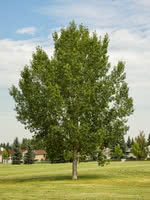Mon-Fri 9am - 5pm Mountain time
Northwest Poplar vs Common Hackberry
Populus x jackii Northwest
Celtis occidentalis
Northwest Poplar is a large and fast-growing tree. Due to its wide spread, this tree makes a great shade or shelterbelt tree. Northwest Poplar tolerates partial shade, drought, and most types of soil. This poplar produces no fuzz.
Northwest Poplar continues to be popular as a shelterbelt species due to the great cost savings that come from the wide spread of the branches. It is a staff favorite because of the wonderful shade it provides all summer long.
The Common Hackberry is a medium-sized deciduous tree that resembles the American Elm but is immune to Dutch Elm Disease. They are versatile and can adapt to a variety of growing conditions.
It produces purple-red, berry-like fruit with a large seed in the center. Both the sweet flesh, which tastes similar to dates, and the crunchy seed are edible. The fruit remains on the tree throughout the winter, offering a valuable food source for birds and other wildlife.
The Common Hackberry can also be a great addition to a pollinator garden. The tree itself is a host for the larvae of several butterfly species and the flowers provide a source of pollen and nectar.
Northwest Poplar Quick Facts
Common Hackberry Quick Facts
In row spacing: 2.4 - 3 m (8 - 10 ft)

